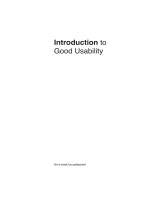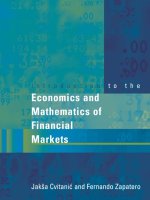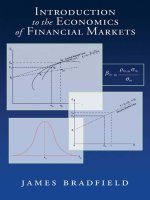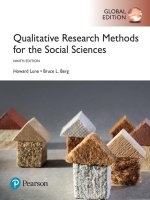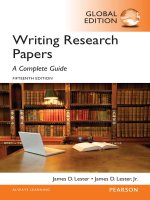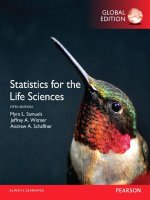Introduction to agricultural economics 6e global edtion by penson
Bạn đang xem bản rút gọn của tài liệu. Xem và tải ngay bản đầy đủ của tài liệu tại đây (12.04 MB, 433 trang )
Introduction to Agricultural Economics
For these Global Editions, the editorial team at Pearson has collaborated
with educators across the world to address a wide range of subjects and
requirements, equipping students with the best possible learning tools.
This Global Edition preserves the cutting-edge approach and pedagogy of
the original, but also features alterations, customization, and adaptation
from the North American version.
SIXTH
edition
Penson, Jr. • Capps, Jr.
Rosson III • Woodward
This is a special edition of an established title widely
used by colleges and universities throughout the world.
Pearson published this exclusive edition for the benefit
of students outside the United States and Canada. If you
purchased this book within the United States or Canada
you should be aware that it has been imported without
the approval of the Publisher or Author.
Global
edition
Global
edition
Global
edition
Introduction to
Agricultural Economics
sixth edition
John B. Penson, Jr. • Oral Capps, Jr.
C. Parr Rosson III • Richard T. Woodward
Pearson Global Edition
PENSON_1292073063_mech.indd 1
10/11/14 4:26 PM
Introduction
to Agricultural
Economics
A01_PENS3064_06_SE_FM.indd 1
12/11/14 3:06 PM
A01_PENS3064_06_SE_FM.indd 2
12/11/14 3:06 PM
Introduction
to Agricultural
Economics
Sixth Edition
global Edition
John B. Penson, Jr.
Texas A&M University
Oral Capps, Jr.
Texas A&M University
C. Parr Rosson III
Texas A&M University
Richard T. Woodward
Texas A&M University
Boston Columbus Indianapolis New York San Francisco Upper Saddle River
Amsterdam Cape Town Dubai London Madrid Milan Munich Paris Montréal Toronto
Delhi Mexico City São Paulo Sydney Hong Kong Seoul Singapore Taipei Tokyo
A01_PENS3064_06_SE_FM.indd 3
12/11/14 3:06 PM
Editorial Director: Vernon R. Anthony
Head of Learning Asset Acquisition, Global
Editions: Laura Dent
Acquisitions Editor, Global Editions: Vrinda Malik
Senior Acquisitions Editor: William Lawrensen
Editorial Assistant: Lara Dimmick
Assistant Project Editor, Global Editions:
Paromita Banerjee
Director of Marketing: Dave Gesell
Marketing Manager: Stacey Martinez
Senior Marketing Coordinator: Alicia Wozniak
Marketing Assistant: Les Roberts
Program Manager: Alexis Duffy
Senior Managing Editor: JoEllen Gohr
Production Project Manager: Susan Hannahs
Senior Production Manufacturing Controller,
Global Editions: Trudy Kimber
Senior Operations Supervisor: Vince Scelta
Operations Specialist: Deidra Skahill
Senior Art Director: Jayne Conte
Cover Designer: Lumina Datamatics, Inc.
Cover Art: © isak55/Shutterstock
Full-Service Project Management:
Lumina Datamatics, Inc.
Credits and acknowledgments borrowed from other sources and reproduced, with permission, in this textbook
appear on the appropriate page within the text.
Pearson Education Limited
Edinburgh Gate
Harlow
Essex CM20 2JE
England
and Associated Companies throughout the world
Visit us on the World Wide Web at: www.pearsonglobaleditions.com
© Pearson Education Limited 2015
The rights of John B. Penson, Jr., Oral Capps, Jr., C. Parr Rosson III, and Richard T. Woodard to be identified as
authors of this work have been asserted by them in accordance with the Copyright, Designs and Patents Act 1988.
Authorized adaptation from the United States edition, entitled Introduction to Agricultural Economics, 6th Edition,
ISBN 978-0-13-337948-8 by John B. Penson, Jr., Oral Capps, Jr., C. Parr Rosson III, and Richard T. Woodward,
published by Pearson Education © 2015.
All rights reserved. No part of this publication may be reproduced, stored in a retrieval system, or transmitted in
any form or by any means, electronic, mechanical, photocopying, recording or otherwise, without either the prior
written permission of the publisher or a license permitting restricted copying in the United Kingdom issued by the
Copyright Licensing Agency Ltd, Saffron House, 6–10 Kirby Street, London EC1N 8TS.
All trademarks used herein are the property of their respective owners. The use of any trademark in this text does
not vest in the author or publisher any trademark ownership rights in such trademarks, nor does the use of such
trademarks imply any affiliation with or endorsement of this book by such owners.
ISBN 10: 1-292-07306-3
ISBN 13: 978-1-292-07306-4
British Library Cataloguing-in-Publication Data
A catalogue record for this book is available from the British Library
10 9 8 7 6 5 4 3 2 1
Typeset in A Garamond Pro by Lumina Datamatics, Inc.
Printed and bound by Courier Kendallville in United States of America
A01_PENS3064_06_SE_FM.indd 4
12/11/14 3:06 PM
We thank our families for their patience and support,
and dedicate this book to them:
My wife Donna; children Matt, John, and Laura;
and my mother Mary Elizabeth for her interest in literature JBP
My wife Debbie, sons Kevin and Eric, and my mother Shirley and grandmother
May Manuel—my most ardent supporters. I am forever grateful to them for inspiring
me to do my best and to always finish strong! OCJ
My wife Helen and sons CP, Henry, and Jonathan CPR
My wife Rosie and children Christopher and Sophia RTW
A01_PENS3064_06_SE_FM.indd 5
12/11/14 3:06 PM
A01_PENS3064_06_SE_FM.indd 6
12/11/14 3:06 PM
contents
part one
Introduction
1
What Is Agricultural Economics? 23
Scope of Economics 24
Scarce Resources 24
Making Choices 25
Definition of Economics 27
Microeconomics versus Macroeconomics 27
Positive versus Normative Economics 27
Alternative Economic Systems 28
Definition of Agricultural Economics 28
What Does an Agricultural Economist Do? 28
Role at Microeconomic Level 29
Role at Macroeconomic Level 29
Marginal Analysis 29
What Lies Ahead? 29
Summary 30
Key Terms 31
Testing Your Economic Quotient 31
References 31
Graphical Analysis 32
2
The U.S. Food and Fiber Industry 35
Indices 36
What is the Food and Fiber Industry? 38
Changing Complexion of Farming 41
Physical Structure 41
Specialization, Diversification, Organization,
and Contracting 41
Productivity 44
Profitability 45
Financial Structure 47
Other Sectors in the Food and Fiber Industry 49
Farm Input Suppliers 50
Food Processors, Wholesalers, and Retailers 50
Value-Added Process 52
7
A01_PENS3064_06_SE_FM.indd 7
12/11/14 3:06 PM
8 contents
Fiber Manufacturers 54
Shippers and Handlers 55
Importance of Export Markets 55
Summary 56
Key Terms 57
Testing Your Economic Quotient 57
References 58
part two
Understanding Consumer Behavior
3
Theory of Consumer Behavior 59
Utility Theory 59
Total Utility 60
Marginal Utility 61
Law of Diminishing Marginal Utility 62
Indifference Curves 62
Concept of Isoutility 63
Marginal Rate of Substitution 64
The Budget Constraint 65
Summary 68
Key Terms 69
Testing Your Economic Quotient 69
Reference 72
4
Consumer Equilibrium and Market Demand 73
Conditions for Consumer Equilibrium 73
Changes in Equilibrium 75
Changes in Product Price 75
Changes in Other Demand Determinants 78
The Law of Demand 80
Market Demand 80
Interpretation of Market Demand 81
Tastes and Preferences 82
Composition of the Population 82
Attitudes toward Nutrition and Health 83
Food Safety 83
Lifestyles 83
Technological Forces 83
Advertising and Promotion 84
Consumer Surplus 84
Summary 85
Key Terms 85
Testing Your Economic Quotient 86
Reference 89
A01_PENS3064_06_SE_FM.indd 8
12/11/14 3:06 PM
contents 9
5
Measurement and Interpretation
of Elasticities 91
Own-Price Elasticity of Demand 92
Income Elasticity of Demand 95
Cross-Price Elasticity of Demand 97
Other General Properties 97
Some Real-World Examples 99
Applicability of Demand Elasticities 101
Applicability to Policymakers 101
Applicability to Farmers 102
Applicability to Consumers 102
Applicability to Input Manufacturers 102
Applicability to Food Processors and
Trade Firms 103
Summary 103
Key Terms 104
Testing Your Economic Quotient 104
References 106
part three
Business Behavior and Market Equilibrium
6
Introduction to Production
and Resource Use 107
Conditions for Perfect Competition 108
Classification of Inputs 108
Land 108
Labor 108
Capital 109
Management 109
Important Production Relationships 110
The Production Function 110
Total Physical Product Curve 111
Marginal Physical Product Curve 112
Average Physical Product Curve 113
Stages of Production 114
Assessing Short-Run Business Costs 115
Total Costs and the TPP Curve 115
Average Costs and the APP Curve 117
Marginal Costs and the MPP Curve 117
Economics of Short-Run Decisions 118
Marginal and Average Revenue 118
Level of Output: MC = MR 118
Level of Resource Use: MVP = MIC 121
A01_PENS3064_06_SE_FM.indd 9
12/11/14 3:06 PM
10 contents
What Lies Ahead? 122
Summary 123
Key Terms 123
Testing Your Economic Quotient 124
7
Economics of Input and Product Substitution 127
Concept and Measurement of Isoquants 128
Rate of Technical Substitution 128
The Iso-Cost Line 130
Least-Cost Use of Inputs for a Given
Output 132
Short-Run Least-Cost Input Use 132
Effects of Input Price Changes 134
Least-Cost Input Use for a Given Budget 134
Long-Run Expansion of Input Use 135
Long-Run Average Costs 135
The Long-Run Planning Curve 136
Economics of Business Expansion 138
Capital Variable in the Long Run 139
Concept and Measurement of the Production Possibilities Frontier 141
Production Possibilities Frontier 141
Product Substitution 142
Concept and Measurement of the
Iso-Revenue Line 143
Profit-Maximizing Combination of
Products 144
Choice of Products in the Short Run 144
Effects of Change in Product Prices 145
Summary 147
Key Terms 147
Testing Your Economic Quotient 148
Reference 151
8
Market Equilibrium and Product Price: Perfect Competition 153
Derivation of the Market Supply Curve 153
Firm Supply Curve 153
Market Supply Curve 154
Own-Price Elasticity of Supply 155
Producer Surplus 156
Market Equilibrium Under Perfect
Competition 157
Market Equilibrium 157
Total Economic Surplus 160
Applicability to Policy Analysis 161
A01_PENS3064_06_SE_FM.indd 10
12/11/14 3:06 PM
contents 11
Adjustments to Market Equilibrium 161
Market Disequilibrium 161
Length of Adjustment Period 162
Cobweb Adjustment Cycle 163
Summary 164
Key Terms 164
Testing Your Economic Quotient 164
9
Market Equilibrium and Product
Price: Imperfect Competition 169
Market Structure Characteristics 170
Number of Firms and Size Distribution 170
Product Differentiation 171
Barriers to Entry 171
Economic Environment 172
Classification of Firms 172
Imperfect Competition in Selling 173
Monopolistic Competition 173
Oligopoly 176
Monopoly 179
Comparison of Alternative Market
Structures 181
Welfare Effects of Imperfect Competition 181
Imperfect Competition in Buying 182
Monopsony 183
Oligopsony and Monopsonistic
Competition 185
Market Structures in Livestock
Industry 186
Governmental Regulatory Measures 187
Legislative Acts 187
Ceiling Price 188
Lump-Sum Tax 189
Minimum Price 189
Summary 191
Key Terms 191
Testing Your Economic Quotient 191
References 194
part four
Government in the Food and Fiber Industry
10
Natural Resources, the Environment, and Agriculture 195
Agriculture and the Environment 196
Water Pollution 196
Air Pollution 198
A01_PENS3064_06_SE_FM.indd 11
12/11/14 3:06 PM
12 contents
Global Climate Change 199
Other Environmental Impacts 201
Economics of the Environment 202
Efficient Property Rights 203
Efficiency and Externalities in
Agriculture 203
Environmental Policies 205
The Economics of the Resources of
Agriculture 208
Soil Quality and Quantity 208
The Economics of Soil Conservation 209
Characteristics of Soil 209
Discounting and Present Value
Analysis 210
The Present Value of Soil Resources 210
Practice: The Dust Bowl 211
Water as an Economic Asset 212
Government Policies for Agriculture, Natural Resources, and the Environment 214
Soil Erosion Policies and the Conservation Reserve Program 214
Other Federal Incentive Programs for Agricultural Conservation 215
Environmental Regulations 215
The Endangered Species Act 216
Summary 217
Key Terms 218
Testing Your Economic Quotient 218
References 220
11
Government Intervention
in Agriculture 221
Rationale for Government Intervention 221
Farm Economic Issues 223
Historical Perspective on the Farm
Problem 223
Forms of Government Intervention 225
Consumer Issues 227
Adequate and Cheap Food Supply 227
Nutrition and Health 228
Food Safety 228
Food Subsidies 228
Historical Support Mechanisms 229
Loan Rate Mechanism 229
Set-Aside Mechanism 231
Target Price Mechanism 233
Countercyclical Payments Mechanism 233
Conservation Reserve Mechanism 234
Commodities Covered by Government Programs 235
A01_PENS3064_06_SE_FM.indd 12
12/11/14 3:06 PM
contents 13
Phasing Out of Supply Management 236
Domestic Demand Expansion Programs 238
Importance of Export Demand 239
Summary 241
Key Terms 242
Testing Your Economic Quotient 242
References 244
part five
Macroeconomics of Agriculture
12
Product Markets and National Output 245
Circular Flow of Payments 246
Barter Economy 246
Monetary Economy 247
Composition and Measurement
of Gross Domestic Product 249
Consumption, Savings, and Investment 250
Determinants of Planned Consumption 251
Determinants of Planned Saving 254
Determinants of Planned Investment 256
Equilibrium National Income and Output 259
Aggregate Expenditures 259
The Keynesian Cross 259
Deriving Aggregate Demand Curve 260
Aggregate Supply and Full
Employment 261
Recessionary and Inflationary Gaps 263
What Lies Ahead? 263
Summary 264
Key Terms 265
Testing Your Economic Quotient 265
References 266
13
Macroeconomic Policy Fundamentals 267
Characteristics of Money 268
Functions of Money 268
Money versus Near Monies 268
Backing of Money 269
Federal Reserve System 269
Organization of the Federal Reserve System 269
Functions of the Federal Reserve System 271
Monetary Policy Instruments 272
A01_PENS3064_06_SE_FM.indd 13
12/11/14 3:06 PM
14 contents
Changing the Money Supply 274
Creation of Deposits 274
Monetary Policy and the Money Supply 277
Money Market Equilibrium 278
Demand for Money 278
Equilibrium Conditions 280
Effects of Monetary Policy on the
Economy 280
Transmission of Policy 280
Combating Recessionary Gaps 280
Combating Inflationary Gaps 282
Microeconomic Perspectives 282
The Federal Budget 284
Federal Expenditures 284
Federal Receipts 285
Budget Deficit 287
The National Debt 288
National Debt and GDP 288
Ownership of National Debt 288
Burdening Future Generations? 290
Fiscal Policy Options 291
Automatic Policy Instruments 291
Discretionary Policy Instruments 292
Fiscal Policy and Aggregate Demand 294
Combating Recessionary Gaps 295
Combating Inflationary Gaps 296
Summary 297
Key Terms 298
Testing Your Economic Quotient 298
References 300
14
Consequences of Business Fluctuations 301
Fluctuations in Business Activity 301
Nature of Business Fluctuations 302
Indicators of Economic Activity 303
Consequences of Business Fluctuations 305
Unemployment 305
Inflation 306
Short-Run Phillips Curve 311
Macroeconomic Policy Options 312
Laissez-faire Macroeconomic Policy 313
Demand-Oriented Macroeconomic Policy 313
Supply-Oriented Macroeconomic Policy 314
Summary 315
Key Terms 316
Testing Your Economic Quotient 316
References 317
A01_PENS3064_06_SE_FM.indd 14
12/11/14 3:06 PM
contents 15
15
Macroeconomic Policy and Agriculture 319
A Historical U.S. Perspective 320
The Big Five 321
Rate of Inflation 322
Rate of Interest 322
Rate of Unemployment 323
Rate of Growth in Real GDP 323
Rate of Foreign Exchange 323
Impacts of Macroeconomic Policy Actions on the General Economy 323
The Real Economy 324
The Monetary Economy 324
Macro-Market-Micro Linkage 325
Impacts of Macroeconomic Policy Actions
on Agriculture 326
Effect of Expansionary Monetary Policy 327
Effect of Contractionary Fiscal Policy 329
Microeconomic Performance Implications 331
Implications for Imperfect Competition 332
Implications for Other Sectors in the
Food and Fiber Industry 333
Summary 333
Key Terms 334
Testing Your Economic Quotient 334
Reference 335
part six
International Agricultural Trade
16
Agricultural Trade and
Exchange Rates 337
Growth and Instability in Agricultural Trade 338
Export Boom and Bust 338
Moves toward Trade Liberalization 339
The Importance of Agricultural Trade 340
Increased Export Dependence 340
Greater Dependence on Imports 340
The Composition of Agricultural Trade 341
The Role of Agricultural Exports 341
The Role of Agricultural Imports 341
Direction of U.S. Agricultural Trade 342
Major Export Markets 342
Major Import Suppliers 342
U.S. Agricultural Trade Performance 342
The Balance of Trade 343
A01_PENS3064_06_SE_FM.indd 15
12/11/14 3:06 PM
16 contents
Exchange Rates and the Foreign Exchange Market 344
Exchange Rates Defined 344
The Foreign Exchange Market 344
The Balance of Payments 347
The Current Account 347
The Capital Account 348
Financial Account 348
The United States as a Debtor Nation 348
The International Monetary System 349
The Gold Standard and the Interwar Years 350
The Bretton Woods System 350
The Present International Monetary System 352
The European Monetary System 353
The European Union and the European
Monetary System 353
Exchange Rate Determination 354
Demand and Supply of Foreign Currencies 354
Relative Interest Rates 355
Changes in Relative Prices 356
Balance of Trade Impacts 357
The Role of Expectations 358
Exchange Rates and U.S. Agricultural Trade 358
Exchange Rate Indices 359
Exchange Rate Impacts on Prices 359
Considerations for Policy Coordination 360
Macroeconomic Policy Coordination 360
Domestic Agricultural Policy Coordination 361
Summary 362
Key Terms 364
Testing Your Economic Quotient 364
References 365
17
Why Nations Trade 367
Why Trade? 367
Absolute Advantage 368
Comparative Advantage 370
Factors Affecting Comparative Advantage 372
Comparative Advantage and Competitive Advantage 372
Gains from Trade 374
The Importance of Exchange and
Specialization 374
Distribution of the Gains from Trade 375
Summary 376
Key Terms 377
Testing Your Economic Quotient 377
References 378
A01_PENS3064_06_SE_FM.indd 16
12/11/14 3:06 PM
contents 17
18
Agricultural Trade Policy and Preferential Trading
Arrangements 379
Trade and Welfare 380
Autarky or the Closed Economy 380
Trade and Partial Equilibrium 381
Welfare Gains from Trade 382
Why Restrict Trade? 383
Protectionism in Agriculture 383
Arguments against Trade 383
Trade Restrictions 385
Import Policies 385
Domestic Agriculture and Food Policies 390
Export Policies 391
Agricultural Trade Policy Making 392
The General Agreement on Tariffs and Trade and the World Trade Organization 392
The United Nations Conference on Trade and Development 394
U.S. Agricultural Trade Policy Formulation 394
The Economic Policy Council 395
The Importance of Preferential Trading Arrangements 396
Forms of Economic Integration 396
Reasons for Preferential Trading
Arrangements 397
Counter Economic and Political Power in Other Parts of the World 398
Reduce Side Effects 398
Foster Political Stability and Economic Prosperity 398
Do Preferential Trading Arrangements Create
or Divert Trade? 399
Static Effects 399
Dynamic Effects 402
Summary 403
Key Terms 404
Testing Your Economic Quotient 405
References 406
Glossary 407
Index 421
A01_PENS3064_06_SE_FM.indd 17
12/11/14 3:06 PM
A01_PENS3064_06_SE_FM.indd 18
12/11/14 3:06 PM
Preface
The purpose of this book is to provide beginning students in agriculture with a systematic introduction to the basic concepts and issues in economics as they relate to
a major segment of the U.S. economy—the food and fiber industry. This process
requires an understanding of the microeconomic and macroeconomic forces influencing the decisions of producers and consumers of food and fiber products, including (1) farmers and ranchers, (2) the agribusinesses that supply them with production
inputs and credit, (3) the agribusinesses that process food products and manufacture
fiber products, and (4) the agribusinesses that provide marketing and related services
at the wholesale and retail levels to both domestic consumers and overseas markets.
We begin the book by answering the question raised in Chapter 1, “What is
agricultural economics?” We first define the field of economics and then develop our
definition of agricultural economics based on the role agricultural economists play at
the micro and macro levels. Chapter 2 provides a historical background by discussing the changing structure of agriculture during the post–World War II period and
of the sectors that supply farmers and ranchers with inputs, process their output, sell
value-added products to domestic consumers, and trade food and fiber products in
the global marketplace.
Part 2 helps students understand the economic decisions made by consumers
of food and fiber products. Topics include the forces influencing consumer behavior
(Chapter 3); the concept of market demand for a particular product (Chapter 4); and
the elasticity of demand (Chapter 5). The specification of key elasticity measures is
supplemented by empirical examples and their relevance to decision-making in the
food and fiber industry, including the potential magnitude of consumer response and
its implication on producer revenue.
Part 3 covers the supply side of the market. Chapter 6 focuses on issues related
to resource use and production responses by businesses in the short run. Chapter 7
discusses the economic forces underlying the firm’s input use, the expansion of the
firm, and the choice of commodities. An introduction to the market supply curve
and determination of market clearing prices and quantities under perfect competition
(Chapter 8) and imperfect competition (Chapter 9) completes this part. This section
of the book includes empirical examples that illustrate the magnitude and applicability
of the relationships covered in these chapters.
Part 4 addresses the role of government in the food and fiber industry. Natural
resources, the environment, and agriculture are covered in Chapter 10. This chapter includes the role of government regulation, which reflects the increasing recognition that natural resources and the environment are scarce resources and require
careful management. The government’s role in providing subsidies to agriculture,
curbing market power, and providing for a secure and safe food supply is addressed
in Chapter 11.
Part 5 focuses on the macroeconomics of agriculture. Chapter 12 outlines the
general linkages between product markets and national output. Chapter 13 documents the importance of monetary and fiscal policy to the performance of the economy. The consequences of business fluctuations in the economy are covered in
Chapter 14. Chapter 15 covers the relationship between macroeconomic policy and
its effects on the economic performance of agriculture.
Part 6 focuses on international agricultural trade issues. Chapter 16 examines the
growth and instability of agricultural trade, including the relative d
ependence on exports
19
A01_PENS3064_06_SE_FM.indd 19
12/11/14 3:06 PM
20 preface
and imports, as well as the foreign exchange market, the international monetary system,
and the effects of foreign exchange rates on U.S. a gricultural trade. Chapter 17 explores
the rationale behind international trade as well as the beneficiaries of international
trade. Finally, Chapter 18 focuses on agricultural trade policy and preferential trade
agreements. This includes issues dealing with trade restriction and whether preferential
trade agreements create or divert trade.
Each chapter concludes with a summary and a list of key terms. A “Testing
Your Economic Quotient” section contains questions and problems to reinforce the
key issues covered. Understanding the answers to these questions and problems will
help students properly prepare for exams. References also are listed at the end of each
chapter.
This book goes beyond the farm gate to address the entire food and fiber industry, which represents a notable percentage of the U.S. national output. This book
places a strong emphasis on the macroeconomics of agriculture, the role of government in agriculture, and international agricultural trade. Experience over the last several decades certainly has shown that farmers and ranchers, agribusinesses, financial
institutions, and consumers of food and fiber products are significantly affected by
macroeconomic policies and trade agreements.
We wish to thank the many students who have given us comments and suggestions during the development phases of this and previous editions of the book.
We also thank the following reviewers for their valuable feedback: James Beierlein,
Penn State University, University Park; Marlies Boyd, Modesto Junior College; and
Stephen King, Western Kentucky University.
John B. Penson, Jr.
Oral Capps, Jr.
C. Parr Rosson III
Richard T. Woodward
Pearson would like to thank and acknowledge Thiagu Ranganathan, Institute
of Economic Growth; and G. Mythili, Indira Gandhi Institute of Development
Research, for their contributions to the Global Edition. Pearson would also like to
thank James E. Allen IV, University of Kentucky; Duncan Farquhar, Charles Sturt
University; Johann Kirsten, University of Pretoria; and Soumyanetra Munshi, Indira
Gandhi Institute of Development Research for reviewing and providing suggestions
that helped in improving the Global Edition.
A01_PENS3064_06_SE_FM.indd 20
12/11/14 3:06 PM
About the Authors
John B. Penson, Jr. John Penson is Regents Professor and Stiles Professor of
Agriculture in the Department of Agricultural Economics at Texas A&M University.
He received a Ph.D. degree in agricultural economics from the University of Illinois
in 1973. He has received numerous teaching and research awards from professional
associations during his career, including the Distinguished Teaching Award from the
American Agricultural Economics Association. Penson has taught courses in Korea,
Japan, Guatemala, Nicaragua, and Ecuador.
Penson’s research has focused on the macroeconomics of agriculture and credit
analysis. This includes the development of quantitative economic models emphasizing the role of the agricultural sector for various state and national economies. His
research has involved projects assessing the implications of macroeconomic policy
for agriculture as well as analysis of lending programs and credit analysis for major
domestic and international lenders.
Oral Capps, Jr. Oral Capps is Regents Professor, Executive Professor, and holder of
the Southwest Dairy Marketing Endowed Chair in the Department of Agricultural
Economics at Texas A&M University. Dr. Capps also is co-director of the
Agribusiness, Food, and Consumer Economics Research Center (AFCERC) in the
Department of Agricultural Economics at Texas A&M University. Dr. Capps was
educated at Virginia Tech University, where he earned a B.S. degree in mathematics
in 1975, M.S. degrees in agricultural economics (1977) and statistics (1979), and a
Ph.D. degree in agricultural economics in 1979.
Capps’s research focuses on demand and price analysis, with particular expertise in
econometric modeling and forecasting methods. His applied research areas include
analyses of expenditure patterns of pre-prepared foods and foods eaten away from
home, analyses of health and nutrition issues, uses of scanner-derived information for
managerial decision-making in food retailing, and analyses of regional, national, and
international markets for the farm, agribusiness, and financial sectors. In addition,
Dr. Capps specializes in unilateral price effects of mergers and acquisitions as well as
evaluations of agricultural checkoff programs.
C. Parr Rosson III Parr Rosson is professor and extension economist with the Texas
AgriLIFE Extension Service. He is also the director of the Center for North American
Studies, Department of Agricultural Economics, at Texas A&M University. Rosson,
now department head, received his B.S. in agronomy from Texas A&M University in
1971 and was commissioned as an infantry officer in the army of the United States,
where he served until 1977. He received an M.S. (1978) and Ph.D. (1982), both in
agricultural economics from Texas A&M University.
Rosson’s extension activities include analysis and impacts of labor, invasive species,
trade agreements, and policy changes resulting from WTO negotiations. Rosson has
25 years of experience working on projects in Mexico, Canada, Central America,
Iraq, Cuba, South America, Europe, Australia, Japan, and developing Asia. This
includes the economic impacts of U.S. agricultural exports to Cuba, irrigation water
use and crop production trends in Chihuahua, Mexico, and the impacts of trade
disruptions due to animal disease outbreaks. He is a member of the USDA/USTR
A01_PENS3064_06_SE_FM.indd 21
21
12/11/14 3:06 PM
22 about the authors
Agricultural Trade Advisory Committee on Grains, Feed, and Oilseeds and chairs the
Agribusiness and Fisheries Committee of the Border Trade Alliance.
Richard T. Woodward Richard Woodward is a full professor in the Department
of Agricultural Economics at Texas A&M University. An environmental economist,
Dr. Woodward received his Ph.D. from the Department of Agricultural and Applied
Economics at the University of Wisconsin. Along with this book, he has been the
author or coauthor of over 30 journal articles and book chapters.
Dr. Woodward’s principal areas of research have been in the use of market-based
approaches to environmental and resource management problems. He has studied the
use of these policies in fisheries, water pollution, and ecosystem services. In 2007 to 2008,
he was a Fulbright Scholar working with the Environment for Development program at
the Tropical Agricultural Research and the Higher Education Center in Costa Rica.
A01_PENS3064_06_SE_FM.indd 22
12/11/14 3:06 PM
1
What Is Agricultural
Economics?
Chapter Outline
Scope of Economics 24
Role at Macroeconomic Level 29
Scarce Resources 24
Marginal Analysis 29
Making Choices 25
What Lies Ahead? 29
Definition of Economics 27
Microeconomics versus
Macroeconomics 27
Positive versus Normative
Economics 27
Alternative Economic Systems 28
Summary 30
Key Terms 31
Testing Your Economic
Quotient 31
References 31
Graphical Analysis 32
Definition of Agricultural
Economics 28
Constructing a Graph 32
What Does an Agricultural
Economist Do? 28
Slope of a Nonlinear Curve 33
Slope of a Linear Curve 33
Role at Microeconomic Level 29
Agricultural economics is an applied social science that deals with how producers,
consumers, and societies use scarce resources in the production, marketing, and
consumption of food and fiber products. In agricultural markets, the forces of supply
and demand are at work. Credit: Brad McMillan/Cartoon Stock.
Agriculture certainly is among the most prominent sectors of any economy. Psalm 104
illustrates this point: “Bless the lord, O my soul, thou dost cause the grass to grow
for the cattle, and plants for man to cultivate, that he may bring forth food from the
Earth.” Unequivocally, agriculture has been a discipline then worthy of study. We specifically are interested in the economic relationships inherent in the agricultural sector.
M01_PENS3064_06_SE_C01.indd 23
12/11/14 1:52 PM
24 chapter one | what is agricultural economics?
The roots of agricultural economics can be traced back to ancient Egypt,
a rguably to the first agricultural economist, Joseph. Joseph interpreted the dreams of
the Pharaoh of Egypt and correctly predicted seven years of feast and seven years of
famine.
What is agricultural economics? If you were to say “Agricultural economics
is the application of economic principles to agriculture,” you would be technically
correct—but in a narrow context. This definition does not recognize the economic,
social, and environmental issues addressed by the agricultural economics profession.
To perceive agricultural economics as being limited only to the economics of farming and ranching operations would be incorrect. These operations annually account
for only 2% to 4% of the nation’s output. Actually, the scope of agricultural economics goes well beyond the farm gate to encompass a broader range of food- and
fiber-related activity, which annually accounts for approximately 12% to 15% of the
nation’s output.
Before we define agricultural economics further, let us first examine the scope
of economics and the role that agricultural economists play in today’s economy. This
examination will allow us to propose a more definitive answer to the question raised
by the chapter title. A more in-depth assessment of the nation’s food and fiber industry is presented in Chapter 2.
scoPE oF EconomIcs
Two frequently used clichés describe the economic problem: “You can’t have your
cake and eat it too,” and “There’s no such thing as a free lunch.” Because we—
individually or collectively—cannot have everything we desire, we must make
choices. Consumers, for example, must make expenditure decisions with a budget
in mind. Their objective is to maximize the satisfaction they derive from allocating their time between work and leisure, and from allocating their available income
to consumption and saving, given current prices and interest rates. Producers must
make production, marketing, and investment decisions with a budget in mind. Their
objective is to maximize the profit of the firm, given its current resources and current
relative prices. After considering the costs and benefits involved, society also must
make choices on how to allocate its scarce resources among different government
programs most efficiently.
Scarce Resources
Scare resources can be
decomposed into natural
and biological resources,
human resources, and manufactured resources.
M01_PENS3064_06_SE_C01.indd 24
The term scarcity refers to the finite quantity of resources that are available to meet
society’s needs. Because nature does not freely provide enough of these resources,
only a limited quantity is available. Scarce resources can be broken down into the
following categories: (1) natural and biological resources; (2) human resources; and
(3) manufactured resources.
natural and biological Resources Land and mineral deposits are examples of
scarce natural resources. The quality of these natural resources in the United
States differs greatly from region to region. Some lands are incapable of growing
anything in its natural state, and other lands are extremely fertile. Still other areas
are rich in coal deposits, or oil and natural gas reserves. In recent years, our society
also has become aware of the increasing scarcity of fresh water, especially in the
West. Whereas energy-related natural resources have represented critical scarce resources in recent decades, water could become the critical scarce natural resource
12/11/14 1:52 PM
